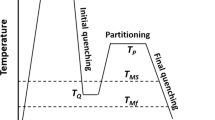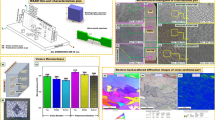Abstract
In order to research the hot deformation of Inconel 625 deposited metal, the Inconel 625 flux-cored wire was surfaced on carbon steel by GMAW. The true stress–strain curves of the deposited metal were obtained by high-temperature tensile test at temperatures of 600–900 °C and strain rate of 8.33 × 10−5 s−1. The tensile fracture morphology and microstructure were observed by OM, SEM, XRD and TEM, and the thermal deformation behavior and strengthening mechanism of the Inconel 625 deposited metal were analyzed. The results show that the longitudinal section of the tensile fracture of specimen can be judged to be mainly composed of γ austenite, MC and Laves phase at different temperatures. And the flow stress decreases with the increase of temperature. The tensile stress–strain curves of the specimens show obvious work-hardening behavior after yielding at RT, 600 °C and 700 °C, while it decreases obviously, and the stress basically maintains a constant at 760 °C, 800 °C and 900 °C. When the temperature is 700 °C, the plasticity of the sample has a low valley, that is medium temperature brittleness. Inconel 625 deposited metal is divided into three stages by Arrhenius relation: the low-temperature zone (T ≤ 600 °C), the medium-temperature zone (600 °C < T ≤ 760 °C) and the high-temperature zone (T > 760 °C). In the low-temperature zone, it consists of a/2 < 110 > dislocation pairs cutting the precipitates or continuous cutting matrix channel and stacking faults of precipitates (continuous stacking fault). The strengthening mechanism is dominated by dislocations cutting γ-phase. With the increase of temperature, some dislocation bands and loops appear in the microstructure, and the dislocation bypass mechanism (Orowan mechanism) has been initiated; in the medium-temperature zone, the complex dislocation reactions occur and form dislocation locks and tangles at 700 °C; it is a mixed mechanism of dislocation cutting and bypassing; in the high-temperature zone, a large number of dislocation loops appear in the microstructure, and some irregular dislocation networks can be observed. With the increase of temperature, the dislocation networks become more regular. It shows that the bypass mechanism of dislocation is the main deformation mechanism.















Similar content being viewed by others
References
Maj P, Koralnik M, Adamczyk-Cieslak B, Romelczyk-Baishya B, Kut S, Pieja T, Mrugala T, Mizera J (2018) Mechanical properties and microstructure of Inconel 625 cylinders used in aerospace industry subjected to flow forming with laser and standard heat treatment. Int J Mater Form 12:135–144. https://doi.org/10.1007/s12289-018-1413-8
Mittra J, Dubey JS, Banerjee S (2003) Acoustic emission technique used for detecting early stages of precipitation during aging of Inconel 625. Scripta Mater 49:1209–1214. https://doi.org/10.1016/s1359-6462(03)00488-3
Neal DE, Philip JM, John PS, Yukinori Y (2008) Microstructure evolution of alloy 625 foil and sheet during creep at 750 °C. Mater Sci Eng A 498:412–420. https://doi.org/10.1016/j.msea.2008.08.017
Rodriguez R, Hayes RW, Berbon PB, Lavernia EJ (2003) Tensile and creep behavior of cryomilled Inco 625. Acta Mater 51:911–929. https://doi.org/10.1016/s1359-6454(02)00494-9
Mathew MD, Parameswaran P, Rao KBS (2008) Microstructural changes in alloy 625 during high temperature creep. Mater Charact 59:508–513. https://doi.org/10.1016/j.matchar.2007.03.007
Mauro MO, Antôinio A, Couto GFC, Almeida DAPR, Nelson BL, Renato B (2019) Mechanical behavior of Inconel 625 at elevated temperatures. Metals 9:301–313. https://doi.org/10.3390/met9030301
Li S, Wei Q, Shi Y, Zhu Z, Zhang D (2015) Microstructure characteristics of Inconel 625 Superalloy manufactured by selective laser melting. J Mater Sci Technol 31:946–958. https://doi.org/10.1016/j.jmst.2014.09.020
Wang JF, Sun QJ, Wang H, Liu JP, Feng JC (2016) Effect of location on microstructure and mechanical properties of additive layer manufactured Inconel 625 using gas tungsten arc welding. Mater Sci Eng A 676:395–405. https://doi.org/10.1016/j.msea.2016.09.015
Lass EA, Stoudt MR, Williams ME, Katz MB, Levine LE, Phan TQ, Gnaeupel-Herold TH, Ng DS (2017) Formation of the Ni3Nb δ-phase in stress-relieved Inconel 625 produced via laser powderbed fusion additive manufacturing. Metall Mater Trans A 48:5547–5559. https://doi.org/10.1007/s11661-017-4304-6
Liu D, Zhang X, Qin X, Ding Y (2017) High-temperature mechanical properties of Inconel-625: role of carbides and delta phase. Mater Sci Technol 33:1610–1617. https://doi.org/10.1080/02670836.2017.1300365
Silva CC, De Miranda HC, MottaF M, Farias JP, Afonso CRM, Ramirez AJ (2013) New insight on the solidification path of an alloy 625 weld overlay. J Mater Res Tech 2:228–237. https://doi.org/10.1016/j.jmrt.2013.02.008
Robin M, Forbes J, Laurence AJ (1999) The structural evolution of superalloy ingots during hot working. JOM 51:27–31. https://doi.org/10.1007/s11837-999-0007-9
Manikandan SGK, Sivakumar D, Rao KP, Kamaraj M (2004) Effect of weld cooling rate on laves phase formation in Inconel 718 fusion zone. J Mater Process Tech 214:358–364. https://doi.org/10.1016/j.jmatprotec.2013.09.006
Sui S, Chen J, Li Z, Li H, Zhao X, Tan H (2020) Investigation of dissolution behavior of Laves phase in Inconel 718 fabricated by laser directed energy deposition. Addit Manuf 32:101055–101085. https://doi.org/10.1016/j.addma.2020.101055
Shankar V, Bhanu Sankara Rao K, Mannan SL (2001) Microstructure and mechanical properties of Inconel 625 superalloy. J Nucl Mater 288:222–232. https://doi.org/10.1016/s0022-3115(00)00723-6
Mu YQ, Wang CS, Zhou WL, Zhou LZ (2018) Effect of Nb on δ phase precipitation and the tensile properties in cast alloy IN625. Metals 8:86–95. https://doi.org/10.3390/met8020086
Suave LM, Cormier J, Bertheau D (2016) High temperature low cycle fatigue properties of alloy 625. Mater Sci Eng A 650:161–170. https://doi.org/10.1016/j.msea.2015.10.023
Xing XX, Di XJ, Wang BS (2014) The effect of post-weld heat treatment temperature on the microstructure of Inconel 625 deposited metal. J Alloys Compd 593:110–116. https://doi.org/10.1016/j.jallcom.2013.12.224
Mostafaei A, Behnamian Y, Krimer YL, Stevens EL, Luo JL, Chmielus M (2016) Effect of solutionizing and aging on the microstructure and mechanical properties of powder bed binder jet printed nickel-based superalloy 625. Mater Design 111:482–491. https://doi.org/10.1016/j.matdes.2016.08.083
Özgün Ö, Gülsoy H, Findik F (2015) The effect of aging treatment on the fracture toughness and impact strength of injection molded In-625 superalloy parts. Mater Charact 108:8–15. https://doi.org/10.1016/j.matchar.2015.08.006
Li C, White R, Fang XY, Weaver M, Guo YB (2017) Microstructure evolution characteristics of inconel 625 alloy from selective laser melting to heat treatment. Mater Sci Eng A 705:20–31. https://doi.org/10.1016/j.msea.2017.08.058
Abolfazl S, Mahmood S, Shafiee MA (2020) Effects of heat treatment on microstructure and mechanical properties of Inconel 625 alloy fabricated by wire arc additive manufacturing process. Trans Nonferrous Met Soc China 30:3016–3030. https://doi.org/10.1016/s1003-6326(20)65439-5
Milligan WW, Antolovich SD (1987) Yielding and deformation behavior of the single crystal superalloy PWA 1480. Metall Mater Trans A 18:85–95. https://doi.org/10.1007/bf02646225
Chu ZK, Yu JJ, Sun XF, Guan HR, Hu ZQ (2009) High-temperature creep deformation and fracture behavior of a directionally solidified Ni-base superalloy DZ95. Metall Mater Trans A 40:2927–2937. https://doi.org/10.1007/s11661-009-0001-4
Cui LQ, Su HH, Yu JJ, Liu JL, Jin T, Sun XF (2017) Temperature dependence of tensile properties and deformation behaviors of nickel-base superalloy M951G. Mater Sci Eng A 696:323–330. https://doi.org/10.1016/j.msea.2017.04.065
Sheng LY, Yang F, Guo JT, Xi TF (2014) Anomalous yield and intermediate temperature brittleness behaviors of directionally solidified nickel-based superalloy. Trans Nonferrous Met Soc China 24:673–681. https://doi.org/10.1016/S1003-6326(14)63110-1
Décamps B, Raujol S, Coujou A, Pettinari-Sturmel F, Clément N, Locq D, Caron P (2007) On the shearing mechanism of gamma’precipitates by a single a/2<110>dissociated matrix dislocations in Ni-based superalloys. Philos Mag A 84:91–107
Nathal MV, Maier RD, Ebert LJ (1982) The influence of cobalt on the microstructure of the nickel-base superalloy MAR-M247. Metal Mater Trans A 13:1775–1783. https://doi.org/10.1007/bf02647833
Nathal MV, Ebert LJ (1985) The influence of cobalt, tantalum, and tungsten on the elevated temperature mechanical properties of single crystal nickel-base superaloys. Metal Mater Trans A 16:1863–1870. https://doi.org/10.1007/bf02670373
Sengupta A, Putatunda SK, Bartosiewicz L, Hangas J, Nailos PJ, Peputapeck M, Alberts FE (1994) Tensile behavior of a new single-crystal nickel-based superalloy(CMSX-4) at room and elevated temperatures. J Mater Eng Perform 3:664–672. https://doi.org/10.1007/bf02645265
Takeuchi S, Kuramoto E (1973) Temperature and orientation dependence of the yield stress in Ni{in3}Ga single crystals. Acta Metall 21:415–425. https://doi.org/10.1016/0001-6160(73)90198-3
Kozar RW, Suzuki A, Milligan WW, Schirra JJ, Savage MF, Pollock TM (2009) Strengthening Mechanisms in Polycrystalline Multimodal Nickel-Base Superalloys. Metal Mater Trans A 40:1588–1603. https://doi.org/10.1007/s11661-009-9858-5
Chu ZK, Yu JJ, Sun XF, Guan HR, Hu ZQ (2010) Tensile property and deformation behavior of a directionally solidified Ni-base superalloy. Mater Sci Eng A 527:3010–3014. https://doi.org/10.1016/j.msea.2010.01.051
He LZ, Zheng Q, Sun XF, Hou GC, Guan HR, Hu ZQ (2004) Low ductility at intermediate temperature of Ni-base superalloy M963. Mater Sci Eng A 380:340–348. https://doi.org/10.1016/j.msea.2004.03.057
Pollock TM, Argon AS (1992) Creep resistance of CMSX-3 nickel base superalloy single crystals. Acta Metall Mater 40:1–30. https://doi.org/10.1016/0956-7151(92)90195-K
Author information
Authors and Affiliations
Contributions
YHS helped in conceptualization, supervision, methodology, project administration, and writing-review and editing. ZYD was involved in conceptualization, methodology, investigation, validation, data curation, and writing-original draft. TSY helped in data curation and investigation. YDW contributed to data curation, methodology, and investigation. XWL was involved in methodology and validation. XGW helped in investigation and resources.
Corresponding author
Ethics declarations
Conflict of interest
The authors declare that they have no conflict of interest.
Additional information
Handling Editor: P. Nash.
Publisher's Note
Springer Nature remains neutral with regard to jurisdictional claims in published maps and institutional affiliations.
Rights and permissions
About this article
Cite this article
Su, Y., Dai, Z., Yang, T. et al. Study on hot deformation behavior and strengthening mechanism of Inconel 625 deposited metal at high temperature. J Mater Sci 56, 16745–16761 (2021). https://doi.org/10.1007/s10853-021-06357-4
Received:
Accepted:
Published:
Issue Date:
DOI: https://doi.org/10.1007/s10853-021-06357-4




